Art Southwest Florida’s review
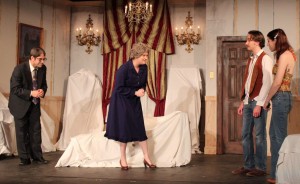 Just in time for Halloween, Lab Theater brings to the stage Ira Levin’s disturbing little tome, Veronica’s Room. It is a story rife with duplicity, betrayal and cultured malevolence. This play is not for the faint of heart. The storyline, characters and underlying themes will stay with you for quite some time.
Just in time for Halloween, Lab Theater brings to the stage Ira Levin’s disturbing little tome, Veronica’s Room. It is a story rife with duplicity, betrayal and cultured malevolence. This play is not for the faint of heart. The storyline, characters and underlying themes will stay with you for quite some time.
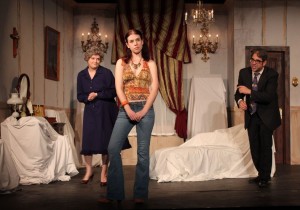 The play takes place in Veronica’s room, an ornately-decorated second-floor bedroom located in an old mansion somewhere in a Boston suburb. The décor is opulent bordering on garish – with gold-striped gray wallpaper over blonde wood wainscoting, gold candelabra sconces and chandeliers, and heavy crimson-and-gold curtains. But more unsettling is the fact that every piece of f
The play takes place in Veronica’s room, an ornately-decorated second-floor bedroom located in an old mansion somewhere in a Boston suburb. The décor is opulent bordering on garish – with gold-striped gray wallpaper over blonde wood wainscoting, gold candelabra sconces and chandeliers, and heavy crimson-and-gold curtains. But more unsettling is the fact that every piece of f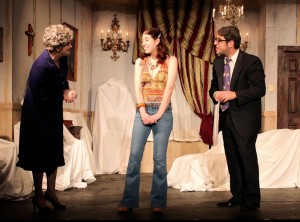 urniture in the room has been carefully covered with white sheets. The room has been preserved as a memorial to a young woman by the name of Veronica who died in 1935 of tuberculosis. You might even say it resembles a mausoleum.
urniture in the room has been carefully covered with white sheets. The room has been preserved as a memorial to a young woman by the name of Veronica who died in 1935 of tuberculosis. You might even say it resembles a mausoleum.
Now 1973, the elderly couple who take care of the house are showing the room to a young couple they met moments ago in a nearby restaurant. The attractive, 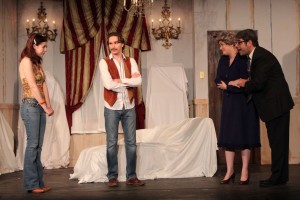 redheaded college coed bears an uncanny resemblance to Veronica and they’ve asked her impersonate the long-dead girl in order to give her elderly sister, Cissie, some peace of mind before she succumbs imminently from late-stage cancer. In her sickness, Cissie now believes that Veronica is still alive but does not come to see her because she is still mad as a result of some
redheaded college coed bears an uncanny resemblance to Veronica and they’ve asked her impersonate the long-dead girl in order to give her elderly sister, Cissie, some peace of mind before she succumbs imminently from late-stage cancer. In her sickness, Cissie now believes that Veronica is still alive but does not come to see her because she is still mad as a result of some 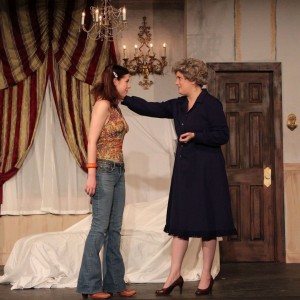 quarrel they had in their youth. Won’t you please dress up in Veronica’s clothes and tell her you forgive her, implore the elderly caretakers. It would mean so much.
quarrel they had in their youth. Won’t you please dress up in Veronica’s clothes and tell her you forgive her, implore the elderly caretakers. It would mean so much.
Over the objections of her date, the tender-hearted young woman named Susan agrees to the charade and dons a forest green satin dress. She allows the housekeeper to do up her hair in the style worn by Veronica back then. With the white sheets now removed from the furniture, Susan excitedly rehearses what she will say to Cissie as she awaits her arrival. 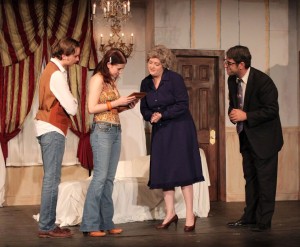 Just then, Susan hears the click of a key in the bedroom door lock. Running to the door, she screams to be let out and bangs on the door with one shoe. As the stage lights dim and the house lights come up, startled audience members look quizzically at one another trying to process what’s just happened and what’s likely to occur in Act Two.
Just then, Susan hears the click of a key in the bedroom door lock. Running to the door, she screams to be let out and bangs on the door with one shoe. As the stage lights dim and the house lights come up, startled audience members look quizzically at one another trying to process what’s just happened and what’s likely to occur in Act Two.
Nothing more can or will be said about the storyline, 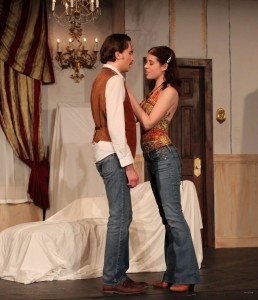 characters or subplots of this taut, frightening play other than that the entire second act is performed at the top of the actors’ lungs and that the action will have you alternatively cringing against your seatback and sitting on the edge of your seat.
characters or subplots of this taut, frightening play other than that the entire second act is performed at the top of the actors’ lungs and that the action will have you alternatively cringing against your seatback and sitting on the edge of your seat.
Kate Dirrigl plays Susan. Although Dirrigl gave hints of her acting skills in previous Lab Theater productions such as The Last Night of Ballyhoo (as the sweetly soft-spoken Sunny Freitag) and Wings (as the patient and kind-hearted stroke therapist Amy), her portrayal of Susan is nothing short of a breakout performance. The role requires Dirrigl to conjure a 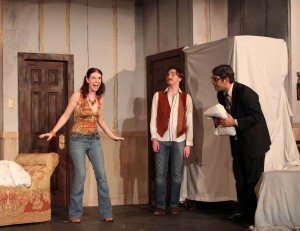 range of complex emotions, not the least of which is anger, resignation and sheer terror. But it’s Dirrigl’s vulnerability that compels the audience to invest itself in her fate, and it’s that dimension of her performance that audiences will find both impressive and memorable.
range of complex emotions, not the least of which is anger, resignation and sheer terror. But it’s Dirrigl’s vulnerability that compels the audience to invest itself in her fate, and it’s that dimension of her performance that audiences will find both impressive and memorable.
Aricka Shuck is equally amazing in the role of The Woman. Hers, too, is a stand-out performance. 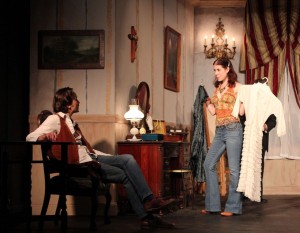 Audiences will be thunderstruck by her ability to project pathological narcissism and unmitigated evil. Once upon a time, Shuck was actor Kim Bassinger’s photo double and stand-in (for the movie 8 Mile). Suffice it to say that Bassinger and other equally accomplished actors could learn a thing or two from Shuck’s performance in Veronica’s Room.
Audiences will be thunderstruck by her ability to project pathological narcissism and unmitigated evil. Once upon a time, Shuck was actor Kim Bassinger’s photo double and stand-in (for the movie 8 Mile). Suffice it to say that Bassinger and other equally accomplished actors could learn a thing or two from Shuck’s performance in Veronica’s Room.
Dave 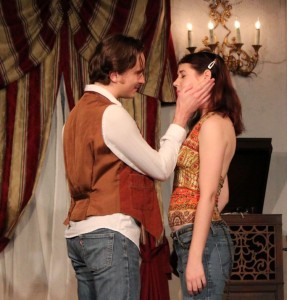 Rode describes his character as creepy. If it’s possible, that’s a gross understatement. He brings new meaning to the terms “fawning” and “obsequious.” And Steven Coe is masterful as the “boyfriend.” It’s a shame more cannot be said of the depth and depravity he brings to bear in his final scene of this dark, sinister play.
Rode describes his character as creepy. If it’s possible, that’s a gross understatement. He brings new meaning to the terms “fawning” and “obsequious.” And Steven Coe is masterful as the “boyfriend.” It’s a shame more cannot be said of the depth and depravity he brings to bear in his final scene of this dark, sinister play.
Director Nykkie Rizley is to be credited with drawing out the best from this talented quartet. “She unpacked moment after moment that was laden with difficult histories and situational complexity,” notes L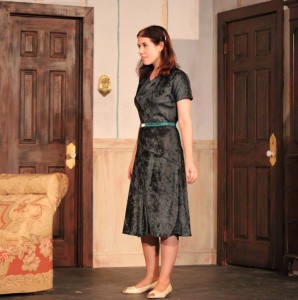 ab’s Artistic Director, Annette Trossbach. “I can see this cast thinking as they are performing … being in the moment and consciously thinking through the thought processes of their characters. It’s what I really like to see on our stage. I am so proud that Nikki continues to raise the bar for our actors and thereby, also for this community.”
ab’s Artistic Director, Annette Trossbach. “I can see this cast thinking as they are performing … being in the moment and consciously thinking through the thought processes of their characters. It’s what I really like to see on our stage. I am so proud that Nikki continues to raise the bar for our actors and thereby, also for this community.”
But there are two other aspects of Veronica’s Room that contribute to the hang-over audiences will experience from this macabre little play. The first is the realization that good-hearted, trusting souls will always 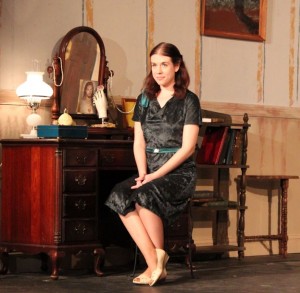 serve as ready victims for those with evil intent. That has always been true. But it seems inescapable that the vast majority of us are simply incapable or unwilling to exercise the vigilance required to stay out of harm’s way, and we routinely disregard that little voice inside that warns us about the people we encounter who mean to do us financial or physical harm.
serve as ready victims for those with evil intent. That has always been true. But it seems inescapable that the vast majority of us are simply incapable or unwilling to exercise the vigilance required to stay out of harm’s way, and we routinely disregard that little voice inside that warns us about the people we encounter who mean to do us financial or physical harm.
That should strike terror into each of our hearts.
Equally troubling is the victim-blaming underlying Veronica’s Room.
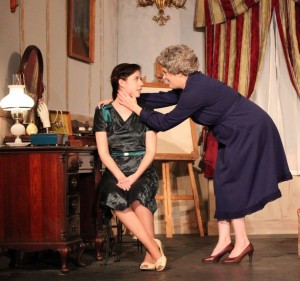 Today, victim bashing has become a sport of epic proportions. As recently as today there have been those who blame Harvey Weinstein’s victims for agreeing to meet him in his hotel room. And in the aftermath of the Las Vegas shootings, one U.S. Congressman said unabashedly that people will just have to learn to “live small” – with the implication that those who do not live small have no expectation of safety within the fabric of present-day American culture.
Today, victim bashing has become a sport of epic proportions. As recently as today there have been those who blame Harvey Weinstein’s victims for agreeing to meet him in his hotel room. And in the aftermath of the Las Vegas shootings, one U.S. Congressman said unabashedly that people will just have to learn to “live small” – with the implication that those who do not live small have no expectation of safety within the fabric of present-day American culture.
S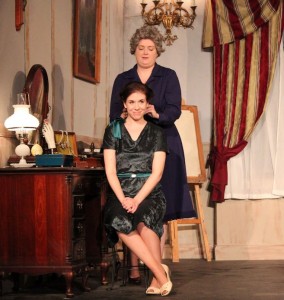 usan is a thrill seeker, a risk taker. And in a seemingly throw-away line of dialogue in Act One, she tells her boyfriend, “I’m promiscuous.” (This is only their second date if you count the day he first met her.) It bears remembering that Veronica’s Room was written at a time pre-AIDS in which young women across the county were just beginning to openly explore their sexuality. Not everyone supported this dramatic social change, and the inclusion of the line requires reflection over whether with it Ira Levin meant to comment on the provincial view that women are supposed to be sacred
usan is a thrill seeker, a risk taker. And in a seemingly throw-away line of dialogue in Act One, she tells her boyfriend, “I’m promiscuous.” (This is only their second date if you count the day he first met her.) It bears remembering that Veronica’s Room was written at a time pre-AIDS in which young women across the county were just beginning to openly explore their sexuality. Not everyone supported this dramatic social change, and the inclusion of the line requires reflection over whether with it Ira Levin meant to comment on the provincial view that women are supposed to be sacred 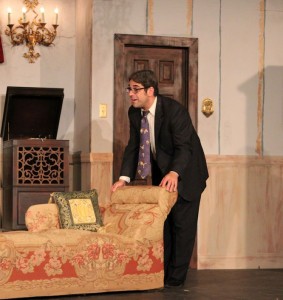 and, inversely, bad girls are likely to meet with bad ends.
and, inversely, bad girls are likely to meet with bad ends.
There are so many reasons to go see this play. Nasty plot, complex characters, brilliant acting, inspired direction, and troubling thematic content – all will leave you gasping for air.
But there is a question you must ask yourself first.
Do you have the courage to enter Victoria’s Room?
October 20, 2017.
RELATED POSTS.
- ‘
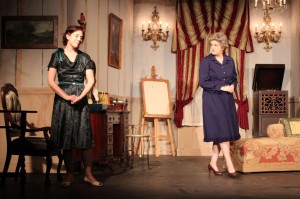 Veronica’s Room’ promises to shock, disturb and scandalize
Veronica’s Room’ promises to shock, disturb and scandalize - ‘Veronica’s Room’ play dates, times and ticket info
- Spotlight on ‘Veronica’s Room’ playwright Ira Levin
- Spotlight on ‘Veronica’s Room’ director Nykkie Rizley
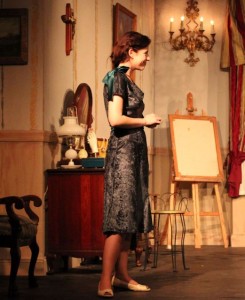 Director Nykkie Rizley talks up cast of ‘Veronica’s Room’
Director Nykkie Rizley talks up cast of ‘Veronica’s Room’- Spotlight on ‘The Woman’ in ‘Veronica’s Room,’ Aricka Shuck
- Spotlight on ‘The Girl’ in ‘Veronica’s Room,’ Kate Dirrigl
- Spotlight on ‘The Boy’ in ‘Veronica’s Room,’ Steven Coe














 Tom Hall is both an amateur artist and aspiring novelist who writes art quest thrillers. He is in the final stages of completing his debut novel titled "Art Detective," a story that fictionalizes the discovery of the fabled billion-dollar Impressionist collection of Parisian art dealer Josse Bernheim-Jeune, thought by many to have perished during World War II when the collection's hiding place, Castle de Rastignac in southern France, was destroyed by the Wehrmacht in reprisal for attacks made by members of the Resistance operating in the area. A former tax attorney, Tom holds a bachelor's degree as well as both a juris doctorate and masters of laws in taxation from the University of Florida. Tom lives in Estero, Florida with his fiancee, Connie, and their four cats.
Tom Hall is both an amateur artist and aspiring novelist who writes art quest thrillers. He is in the final stages of completing his debut novel titled "Art Detective," a story that fictionalizes the discovery of the fabled billion-dollar Impressionist collection of Parisian art dealer Josse Bernheim-Jeune, thought by many to have perished during World War II when the collection's hiding place, Castle de Rastignac in southern France, was destroyed by the Wehrmacht in reprisal for attacks made by members of the Resistance operating in the area. A former tax attorney, Tom holds a bachelor's degree as well as both a juris doctorate and masters of laws in taxation from the University of Florida. Tom lives in Estero, Florida with his fiancee, Connie, and their four cats.